Orange Star Plant (Ornithogalum Dubium): Care and Growing Guide (Pictures)
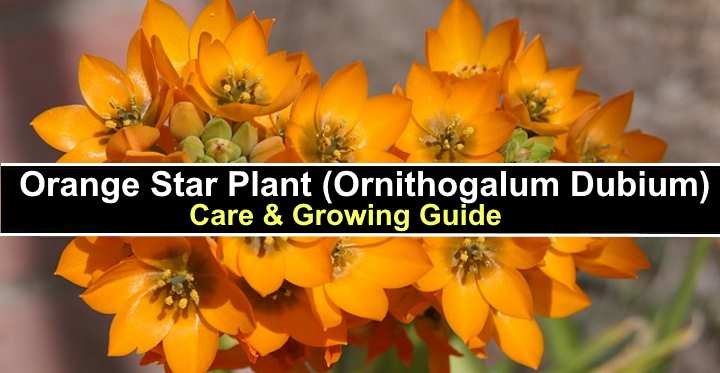
The orange star plant is a beautiful ornamental plant with clusters of star-shaped orange flowers growing on the end of tall stems among lime-green foliage. Also called the Star of Bethlehem and Sun Star, the orange star flowers form a spectacular bouquet of 15 to 20 small blossoms, each with six triangular orange petals. Orange star plant thrives in gardens in sandy soil where it gets full sun for most of the day.
This article is a guide to growing an orange star plant in a garden landscape. Although the bulbous flowering plant is easy to grow, there are a few specific care requirements to ensure the plant’s orange blossoms last the whole season. Additionally, you will learn how to resolve issues when growing the orange-flowering plants.
Orange Star Plant Facts
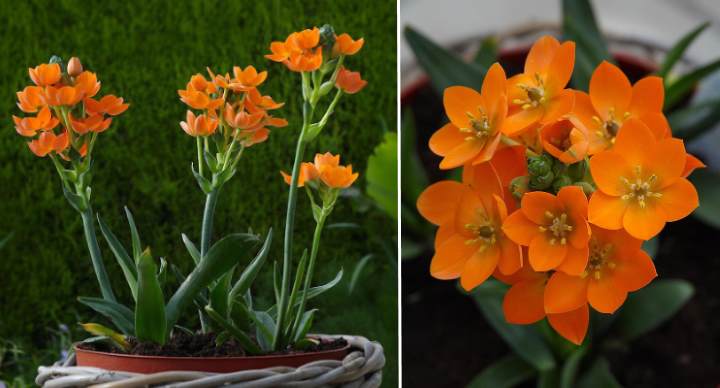
Orange star plant (Ornithogalum dubium)
The orange star plant (Ornithogalum dubium) is a bulbous plant in the hyacinth family Scilloideae. As an attractive perennial plant, the orange star plant grows between 12” and 20” (30 – 50 cm) tall. The plant’s dark green to lime-green leaves are lanceolate-shaped and grow 4” to 10” (10 – 25 cm).
The natural habitat of the orange star plant is South Africa. In the wild, the plant grows in sandy soil, where it gets plenty of sunlight. Typically, clusters of orange flowers bloom in winter or spring. The six-petalled flowers are in varying shades of orange, depending on the sunlight and climate.
Orange star plants thrive outdoors in USDA zones 7 through 11 in hot and humid conditions. The beautiful orange plant looks spectacular in rock gardens, where it will grow year after year from bulbs. If you live in colder climates, you can dig the bulbs up and overwinter them before replanting the following spring.
It is possible to grow orange star plants in pots indoors. Unfortunately, the plant’s specific sun requirements mean that potted orange star plants don’t bloom well in the home. However, the orange flower clusters make attractive cut flowers in floral arrangements.
How to Care For Orange Star Plant
To care for an orange star plant, grow the bulbs in loamy, well-drained soil in the sunniest part of your garden. Water the ground when the top 2” of soil is dry. On hot summer days, water frequently to ensure the soil is moist. Apply a diluted fertilizer every four to six weeks.
If you grow a potted orange star plant indoors, keep the plant in bright sunlight where it gets at least six hours of light. Only water the potting mix when the top layer is dry and never allow the soil to dry out or become waterlogged.
Orange Star Flower
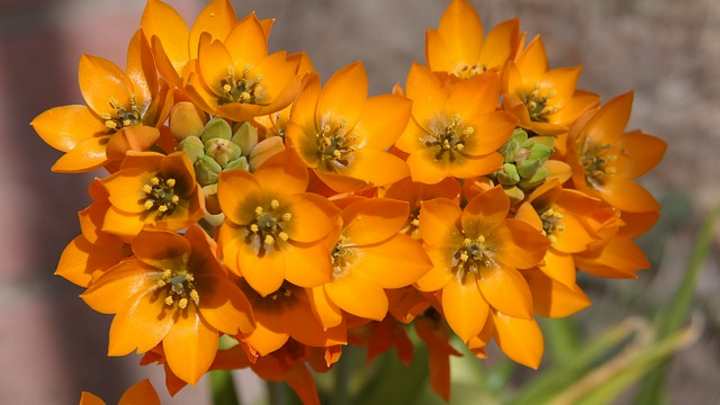
Orange star flower cluster
Orange star plants are primarily grown for their ornamental orange flowers. Each star-shaped orange flower consists of six petals in an open cup shape, measuring 1” (2.5 cm) across. The flower’s center is brown or black, adding to the beauty of the orange plant. Flower clusters contain five to 25 orange flowers.
Orange Star (Ornithogalum dubium) Care Guide
Let’s look in more detail at how to grow an orange star plant so that it blooms for a long time and flowers year after year.
Where to Grow Orange Star Plant
Plant orange star plant (Ornithogalum dubium) bulbs in the sunniest spot in your garden. You should also choose a location with sandy or loamy soil that drains well. So, a rock garden or raised bed is an ideal place in your garden to plant orange star bulbs.
Orange Star Plant Light Requirements
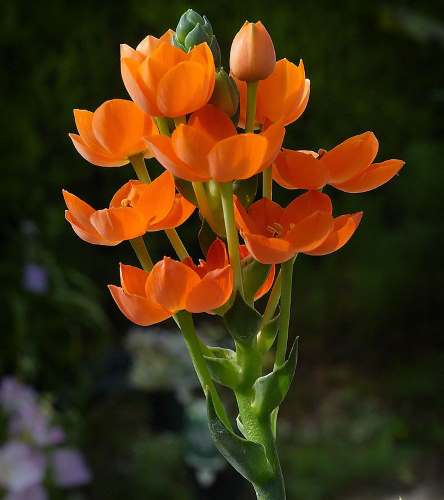
Orange star plant requires plenty of sunlight
Orange star plants require full sun, at least six hours daily. Growing sun star plants in direct sunlight ensures more flowers and a longer blooming time. On scorching sunny days, provide some afternoon shade.
Sun star plants don’t perform well outdoors in the shade. This means that you shouldn’t plant the orange star flower bulbs under trees or in flower beds that are in constant shadow. Not enough sunlight can result in fewer blooms and bulbs that don’t perform well in overly damp, cool soil.
Other signs that your beautiful orange star plant lacks light are slow growth, poor blooming, yellowing leaves, and flowers that wilt quickly. If you notice that the sun star plant’s growth is weak and slow, move it to a brighter location.
When growing orange star flowers indoors, the best location is in a warm spot where they get at least six hours of indirect light and a little direct sunlight. Placing the potted plant on an east-facing window is an ideal location for the best blooms. At a south-facing or west-facing window, ensure the orange star plant gets some protection from the afternoon sun.
Orange Star Plant Soil Requirements
Orange star flowers perform best in well-drained loamy, fertile soil. The plant’s bulbs are prone to rot if the soil is too soggy or waterlogged. When growing orange star plants in a garden landscape, ensure good drainage where the bulbs are growing.
If you live in colder climates, it’s best to dig up the bulbs at the start of fall. Removing the plants prevents cold, wet soil from destroying them during winter. Later in the article, you will find out how to overwinter Ornithogalum dubium bulbs.
Potted orange star plants need to grow in a fertile potting mix amended with sphagnum peat moss and perlite. Use equal parts of regular houseplant soil, peat moss, and perlite for the potting soil. The addition of peat moss acts as a moisture retainer, and perlite helps with drainage.
Related reading: How to make a homemade potting mix for houseplants.
How to Water Orange Star Plant
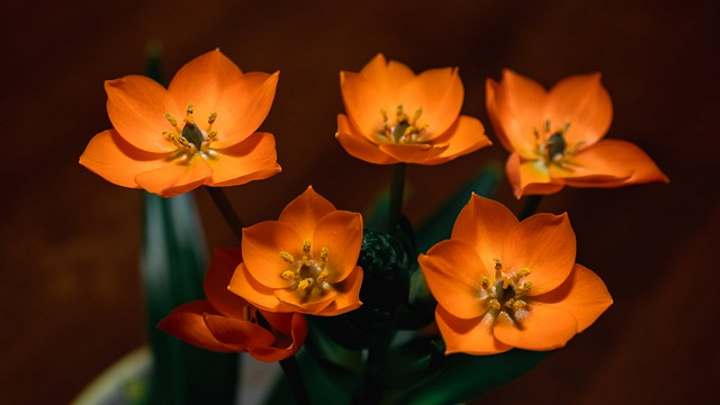
Water the orange star plant whenever the top layer of soil is dry
Orange star plants need sufficient water to thrive outdoors and indoors. Water the sun star plant enough so that the bulbs in the ground grow in moist soil. The best way to ensure this without making the ground soggy is to water whenever the top 2” (5 cm) of soil is dry.
Typically, an orange star plant needs weekly watering during spring and summer. However, if the weather is especially hot, you may have to water the ground twice a week. If you leave the bulbs in the ground over winter, then water just enough to keep the soil damp.
Sun star plants growing in pots need moist soil to thrive. Like growing outdoors, only water the potting soil when the top layer of soil is dry. Give the soil a drenching until water drains out the pot’s drainage holes. Then place the pot in a warm, sunny spot to continue growing.
Getting a watering schedule right is the most critical care factor when growing an orange star plant.
Signs of underwatering the Ornithogalum plant are flowers dropping, slow growth, or yellowing leaves. It’s good to remember that orange stars are not drought tolerant of plants.
Signs of overwatering an orange star flower include mushy black stems, wilting growth, and eventual plant death. Potted indoor orange star plants don’t require watering during the winter months.
Temperature Requirements for Orange Star Flower
Orange star plants thrive in warm temperatures between 60°F and 80°F (16° – 27°C). The plants are not cold-hardy and don’t survive in the ground in colder climates. Therefore, average room temperatures are ideal for growing the plant indoors.
Generally, orange star plants perform best in USDA zones 7 to 11. In the hottest climates, the plants will appreciate some protection from the afternoon sun. In zones 6 and below, you can grow orange star plants in the ground if you overwinter them indoors in a cool, dry place. Or you could keep the heat-loving orange plants in containers and bring them indoors from fall until early spring.
The orange star plant is sensitive to sudden temperature changes. If the container plant is growing indoors, keep it away from the air conditioner airflow, drafts from open windows, and hot radiators.
Humidity Requirements for Orange Star Plant
An orange star plant has no particular humidity needs growing in the right outdoor environment. If the plant is getting plenty of sunlight, growing in well-drained sandy soil and moist ground, you should have no growing issues. Only ensure that the foliage gets plenty of air circulation.
Potted indoor orange star plants only require average room humidity to thrive. High levels of humidity and poor air circulation can cause fungal issues like powdery mildew to develop. Additionally, there is no need to mist the foliage, as this can cause problems with leaf spot.
Related reading: How to get rid of white mold from plant leaves.
Fertilizing Orange Star
The orange star plant benefits from regular fertilization if you want plenty of orange flowers. Use a high-potassium fertilizer that helps boost flower growth. A fertilizer for ornamental plants should replenish nutrients in the soil that the plant needs for blooming.
There are many types of organic fertilizers suitable for flowering garden plants. However, it is always important to follow the manufacturer’s guidelines in the amount of fertilizer to use. Additionally, digging in organic compost in spring can help boost orange star plant growth.
Fertilize potted orange star plants once a month with a diluted all-purpose houseplant feed. From spring through summer, the orange flowering plant will thrive. However, during the winter months, you should hold back from watering and fertilizing.
Pruning Orange Star Plants
The only pruning that an orange star plant needs is to remove yellowing or dead leaves. You can cut the leaves to the ground to help improve the plant’s appearance and to concentrate growth in healthy foliage. After flowering, the orange star plant’s foliage will die back and become dormant.
Orange Star Plant Propagation
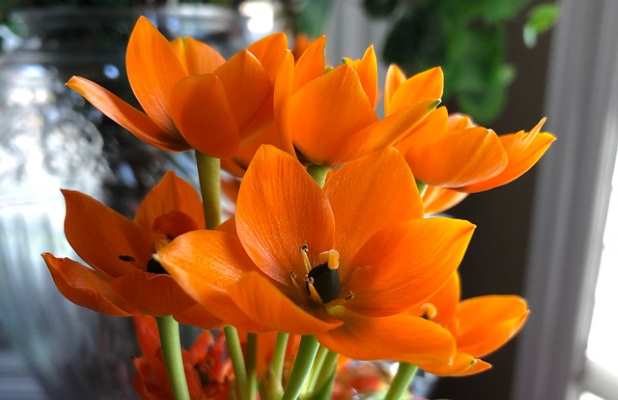
You can propagate an orange star plant by dividing the bulbs
The easiest way to propagate an orange star plant is to separate offsets from the bulbs in fall. First, dig up the bulbs and look for small bulbs attached to the main plant. Next, use a sharp, sterilized knife to separate the bulbs and then plant in pots or back in the ground. You can divide the bulbs every five or six years.
Propagated orange star bulbs in pots should grow in a cool area and moist soil during winter. New growth should appear in spring.
Another way to grow a new Ornithogalum dubium plant is to collect seeds after flowering. Toward the end of summer, the seed pods turn brown. Remove the seed pods before they drop to the ground and allow them to dry for a week. Then, carefully remove the tiny seeds and store them in a cool, dry environment.
You can plant seeds in the fall or spring in a light, moist potting mix that is an equal combination of peat moss, fine bark, and perlite. Cover the seeds with a light amount of soil and keep them in a shady location. By spring, the seedlings should have germinated. It takes up to four years for an orange star plant to bloom.
Repotting Orange Star Plants
Repot orange star plants once a year at the end of summer. Repotting in a larger pot gives the bulbs more room to grow. Additionally, you can refresh the potting soil, remove offsets for propagation, and check the health of the plant’s bulb.
To repot the orange star plant, remove the bulb from its current container. Fill a new pot with the appropriate potting soil and put the bulb at the same depth as before. Water thoroughly and put the newly-potted orange star plant in a bright place.
Sun Star Plant Winter Care
In colder climates, Ornithogalum bulbs need protection from frost. Before the first frost date, it’s vital to dig up the bulbs from the ground and remove any foliage. Leave the bulbs in a cool, dark place to dry.
You can then plant the bulbs back in the ground the following spring after any risk of frost has passed.
If you leave the bulbs in the garden during mild winters, you can cover them with a thick layer of mulch to protect them.
Pests Affecting Orange Star Plant Growth
Orange star plants are relatively hardy plants and don’t succumb to houseplant pests easily. Growing indoors or outdoors, thrips are the only pest to affect a sun star plant’s growth. You can get rid of thrips from garden plants by using a hose and a strong jet of water.
If you have thrips on an orange star plant growing indoors, you will need to isolate the plant from your other houseplants. Then, once a week, use a neem oil spray to douse the plant’s foliage and damage the thrips’ lifecycle. After that, continue using the natural insecticide spray until all signs of pests are gone.
Related reading: How to identify the signs of thrips.
Diseases Affecting Orange Star Plant Growth
The most common disease to affect an orange star plant is root rot. Overwatering a plant can cause the bulbs to decay, become rotten, and eventually die. Additionally, storing bulbs through winter in damp conditions could cause them to rot.
To avoid root rot, always water the orange star plant correctly. So, wait until the top layer of the ground or potting mix is dry. Then give the soil a soaking to hydrate the bulbs. The next time to water the plant is when the soil partially dries again.
Orange Star Plant Care – FAQs
Is the orange star plant toxic?
All parts of the orange star plant (Ornithogalum dubium) are toxic if ingested. Therefore, the plant’s leaves, roots, and flowers are poisonous to dogs, cats, and humans.
Why are my orange star plant leaves becoming yellow?
The most common reasons orange star plants turn yellow are a lack of sunlight, poor soil condition, or too much water. The best way to restore the plant’s health is to grow it in a sunny place and only water it when the soil dries partially.
Do Sun Star plants come back every year?
Orange star plants come back year after year if the bulbs survive the winter. To ensure regular blooming, grow the plants in sandy soil if you live in zone 7 and above. In colder climates, protect the orange star bulbs from frost by bringing them indoors.
Related articles:
